Fermented juniper berry juice (smreka or kleka) is the most popular recipe on our website. Bittersweet and tangy, this refreshing, lemonade-like beverage is incredible! We guarantee people will be begging you for one more glass (and you'll pretend you didn't hear them)!

Jump to:
Background
In the Balkans, the juniper tree is synonymous with the juice made from its berries. Here, it goes by the name of smreka (Bosnia and Herzegovina, North Macedonia), kleka (Croatia, Serbia), brin, brina (Slovenia), and more.
(Note that in some Balkan regions kleka is also the name used for rakija, or homemade brandy, made from juniper berries.)
If you read "fermented juniper juice" and thought sauerkraut or kimchi, you're far off! Think of smreka as a bittersweet lemonade. You can consume it as is, sweeten with honey or sugar, and even mix it with fresh or soda water.
But, let's talk about this amazing plant first!
Juniper (juniperus communis), known as the common juniper, is an evergreen plant from the cypress family. It consists of bushes and small trees standing at about 3-6 feet, with rare ones as tall as 50 feet.
Think of juniper tree berries as bluer and harder blueberries. The berry fruit is about 1-inch in diameter. It starts off as a green, meaty berry that eventually matures into midnight blue. This takes 2-3 years.
This is what they look like:
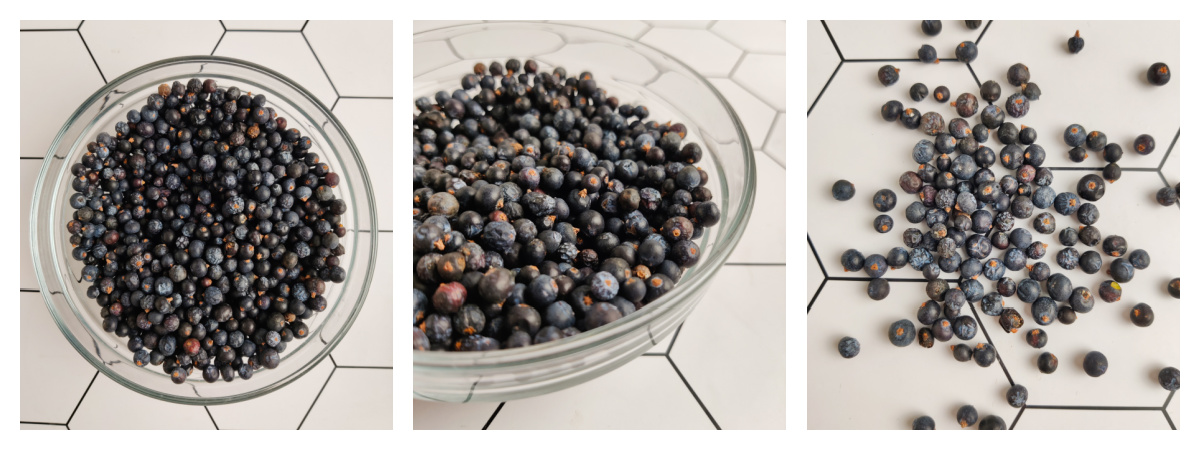
Bittersweet juniper berries, and juniper tree needles, are used for:
- drinks (teas, gin, rakija, and juice),
- esoteric oils,
- food extracts and seasonings (kielbasa and game),
- and even medicine.
As we've had 100s of questions about fermented juniper berry juice, juniper berries, and juniper trees over the years, today we'll share all our knowledge. We've made smreka again and again, read everything we could find, and even called up smreka sellers to ask for their secrets.
It turned out, we were doing it great from the start! By following these instructions you should make this juniper berry drink easily from the first try. It's easy, we promise!
However, read through the entire article!
Unlike fermented cabbage, juniper berry juice, smreka, needs just a little more attention. (Comment section below the recipe also might be helpful to you.)
For simplicity, much of the information is in the FAQs section.
Ingredients
Here are the ingredients necessary to make juniper berry juice smreka.
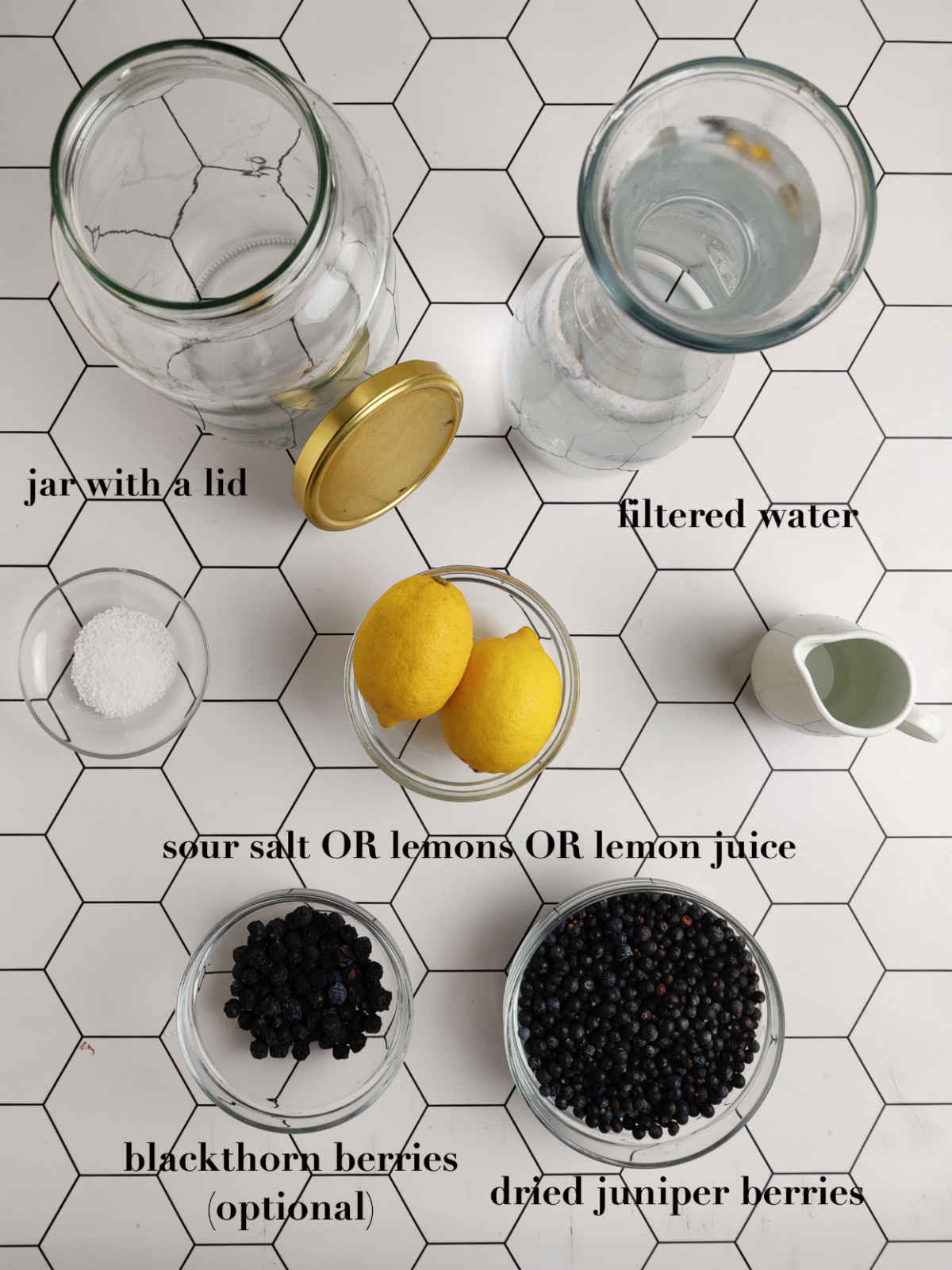
- Juniper berries: And... You can use the same batch more than once.
Although you can get away with using just juniper berries and water for fermenting, a sour element helps the process a lot. You can use one of the following:
- Lemons: Fresh lemons cut into rounds or quartered. (Use a fresh batch of lemons each time you use and reuse juniper berries.) Lemons go bad quicker (they have a tendency to get moldy sooner rather than later), so most people nowadays prefer the other options to speed up the fermentation. OR
- Fresh lemon juice: Juice from 2 lemons also works; OR
- Sour salt (aka lemon salt or citric acid): Can also be used to speed up the fermentation process. You'll need a couple of teaspoons.
Optional, but tasty additions:
- Blackthorn: A handful of blackthorn is sometimes used to give the juice a reddish hue.
- Apples: Some people put sliced sour apples in their juniper berry juice (Granny Smiths, for example). This gives it a slight wine aroma.
- Rosehip: For a wonderful smell.
- Cornelian Cherries.
Instructions
Here are instructions for juniper berry juice (smreka). For more detailed instructions look at the recipe card.
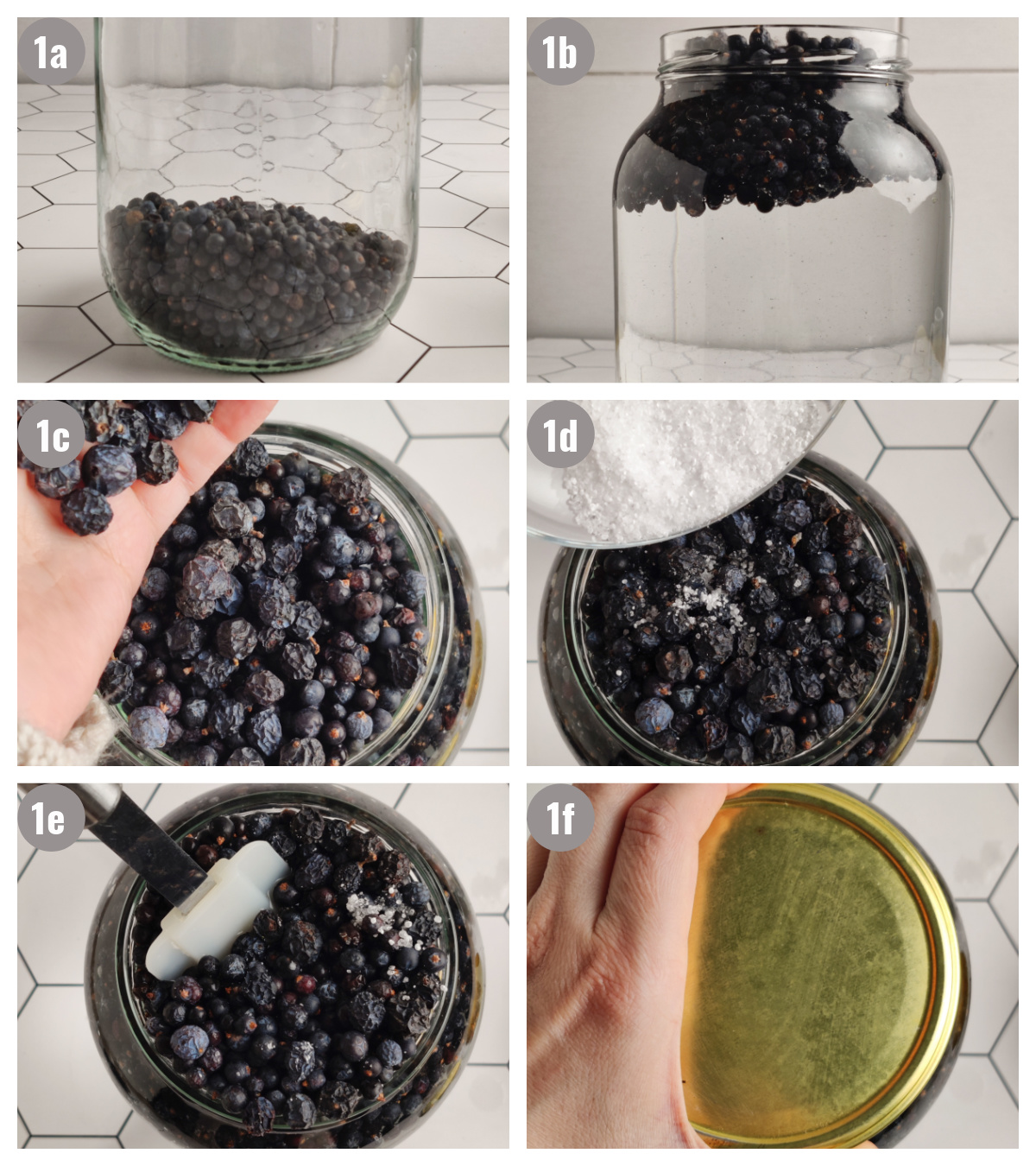
Step 1. Add juniper berries and sliced lemons (or lemon salt or juice), and any other ingredients to a clean jar. Close it tightly.
Step 2. (Not pictured) Place the jar in a fermentation spot (look at expert tips!). Every couple of days open the jar and stir the ingredients. It's done when the juice is tangy and of a minty-yellow hue (reddish if you add sloe).
Step 3. (Not pictured) Strain the juniper berry juice (smreka) into a glass bottle(s). Cap the bottles and transfer them to the fridge for up to 2 weeks. When serving dilute if needed. Reuse berries up to 3 times.
Handling
Serving: Serve juniper berry juice (smreka) cold or chilled. If you find it strong, dilute it with fresh or mineral water. Per your preference sweeten with honey or sugar.
Storing: Store smreka in glass bottles with a cork or lid, in the fridge for up to 2 weeks.
Recipe FAQs
Both.
Juniper berries are harvested in the fall. As per Balkan tradition, it's best to harvest juniper berries right after the first or second frost. They fall off easily at this point.
To harvest them, place an umbrella or a sheet underneath the tree and gently shake it. Ripe juniper berries will fall off on their own. To protect yourself from needles and allergies, wear long pants, a long-sleeved shirt, and gloves.
(Leave about 20% of the berries on the tree so that it can regenerate itself.)
Some harvest juniper with more force using sticks or vigorous shaking. This method requires more time as you'll have to separate ripe berries from unripe ones and the juniper needles.
While we prefer the gentler method, adjust it to your needs. If you have a whole forest of juniper berries to harvest, obviously the rougher method might be of more use to you.
After harvesting, let the berries rest outside on the sheet for an hour. This ensures that any insects that happen to be there leave, and you don't bring them into your home.
The best way is naturally.
The easiest way is to spread the berries out on a large sheet in a drafty and dry place, away from kids and animals. (Avoid sunny or overly warm spots.) This can be a basement with a window, garage, or guest room. The room temperature is usually fine.
Leave it there for a day, and then pack in a bag made with natural products (paper bag, gunny sack, etc.). Juniper berries will continue drying when packed, so you can use them all year long.
Although we haven't tried it, some report using dehydrators to dry juniper berries. We don't find this necessary for juniper berry juice (smreka).
Yes. Check them out here, here, and here.
Note that while we're an Amazon affiliate, we did not buy directly from these stores and cannot vouch for the quality of their berries.
Obviously, if you live in a juniper tree rich state you can harvest your own, or look for them at your local farmer's market.
If you're collecting juniper berries for your own use, keep them in natural materials, like a paper bag, a wooden box with a lid, a gunny sack, or a cardboard box.
Warning!
Please consult with your doctor or healthcare provider before using juniper berries and juniper needles for health benefits! We're not certified to dispense medical advice.
Keeping that in mind, here are some alleged health benefits from the juniper berries according to Balkan sources.
Juniper berry juice is a great diuretic. It's recommended for patients with kidney stones and diabetes. It's also supposed to help with GI tract issues and migraines. It helps with inflammation too, and its oils are used for massaging individuals suffering from rheumatoid arthritis.
Avoid consuming if you're pregnant or nursing.
Don't panic! You're probably seeing kahm yeast which looks like a layer of white scrum. It's not dangerous!
Simply remove it with a spoon and seal the lid again. (If you're really worried and think it's necessary, strain the juice, wash the berries, and combine them again in your jar. Then continue the fermentation process until the juice is done.) You can read more about kahm yeast here.
If you're worried that what you're seeing is mold, here is a great article on what to do.
We found the magic number to be two for juniper berry juice (smreka). You may get away with it three times.
Expert Tips
Fermentation spot:
- Find a relatively warm spot. Terraces and balconies work well. As do tops of cabinets or warm spots in the kitchen or home. The only requirement is that the spot is relatively warm. (Smreka doesn't have to be exposed to sunlight.)
- If you live in a very humid environment it'll be done quicker.
- For example, I live in a continental climate with warm summers and snowy winters. I make smreka juice on my window sill facing south. As the window is right above the radiator, it takes about the same time to make it year-round. The average temperature in this spot is 24-26°C (75-78°F).
Fermentation length:
- As with most fermentations, there is no rule cut in stone. Sometimes juniper berry juice (smreka) will ferment for 7 days, and sometimes way beyond 15 days. This greatly depends on the fermentation spot (look above), and the climate you live in. Our sweet spot is between 10 days and 2 weeks.
- (Reading the comment section may be helpful here, as people have different experiences.)
- A good way to find out if your juice is ready to simply try it. (A good time to do this is when you're stirring the juice.) If it's minty-yellow and tastes tangy, sour, and slightly carbonated, it's ready. (If you add something like blackthorn berries, your juice will be reddish.)
Fermenting the same berries again:
-You'll get the best juice the first and second time using the same batch. You may get away with it the third time, but the juice won't be as strong or flavorful. When you reuse the berries you'll notice them falling to the jar's bottom quicker.
Movement of juniper berries:
You'll notice berries "walking" up and down the jar. That's perfectly normal.
Similar Recipes
Here are a few Balkan beverages just as tasty as juniper berry juice (smreka) that you'll enjoy:
- Homemade mint tea - why buy it, if you can make your own?
- Elderberry Cordial - fancy a picnic in a cup, m'dear?
- Care for a heavenly liqueur? Višnja, or sour cherry liquid will awaken the senses!
Thoughts?
If you make fermented juniper berry juice (smreka or kleka) and like it, please consider giving it a ⭐️⭐️⭐️⭐️⭐️ (5-star) rating. This helps others find the recipe more easily!
Also, feel free to leave a comment (I read each one!), and don't forget to tag a photo #balkanlunchbox, or us @balkanlunchbox, on IG.
Prijatno and bon appetit!
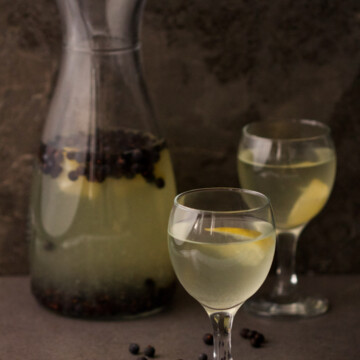
Fermented Juniper Berry Juice (Smreka, Kleka)
Equipment
- 1 glass jar with lid volume of 1-gallon volume (or a 3 liter jar if using metric volumes)
Ingredients
- 2-3 lemons OR juice of 2-3 lemons, OR 3 tsps sour salt (citric acid or lemon salt)
- 12-14 ounces juniper berries just harvested or dry berries both work
- filtered or boiled water enough to fill the jar with berries
- (Optional) a handful or two of blackthorn berries (sloe) used to give a reddish hue
Instructions
- In a clean glass jar add juniper berries and sliced lemons (or lemon salt or juice). If adding sloe add it now also. Fill the jar to the top with filtered or boiled water. Stir very lightly, and tightly close the lid.
- Place the jar in your fermentation spot (look below). Leave for 10-15 days. Every couple of days open the jar and stir the contents. You can taste it at this point too, and see if it's to your liking.
- During the fermentation process, some juniper berries will sink to the bottom, or even travel up and down in the jar. As the days go by the liquid will eventually take on a minty-yellow hue. (If you put in blackthorn berries/ sloe, this hue will be reddish.) Try the juice and if it's tangy and on the sour side, it is done.
- Strain the juice into a glass bottle(s). (Keep the berries, and set them aside.) Cork or cap the bottles and transfer them to the fridge. Keep the juice in the fridge for up to 2 weeks.
- When getting ready to consume the juice, taste to decide if the sourness level is to your liking. The drink is healthiest as is, but if you find it too strong, you can dilute with water. Alternatively use mineral water, but this will add a little more carbonation to the juice. If you prefer it sweeter, you can add a teaspoon of sugar, or honey.
Making a second or third batch with the same juniper berries
- Take the berries you set aside after straining the juice. (Discard any remaining lemon pieces.) Wash the berries and clean the jar. Return the berries to the jar, and add new lemon pieces (or lemon salt or juice), and filtered water. Stir and screw the lid on again, and repeat the fermentation process.
- The second and third time around the berries will fall to the bottom more quickly. When most of them stay on the bottom, and the juice is no longer flavorful, berries are ready to be discarded. This is usually after the second time using the same batch, although sometimes you can get away with using the same batch of berries three times.

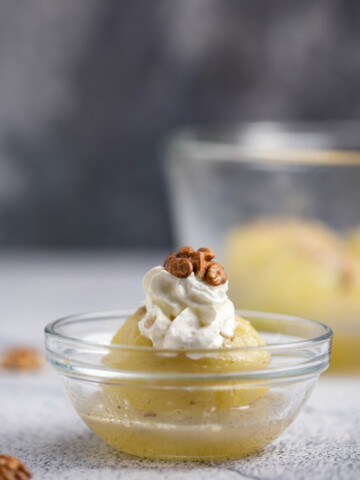
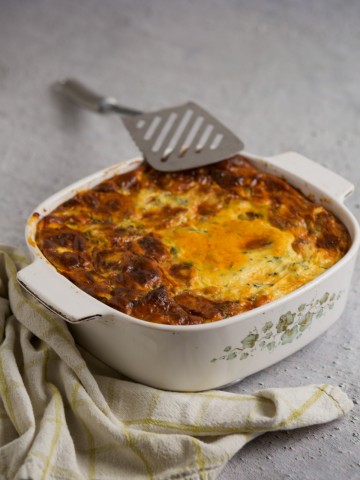
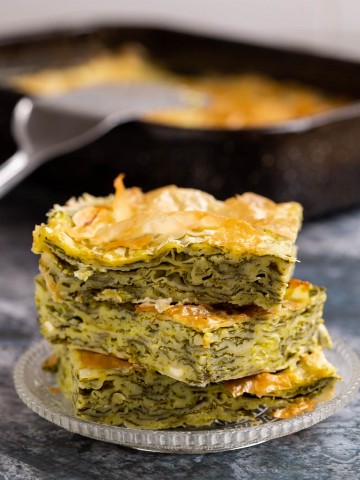
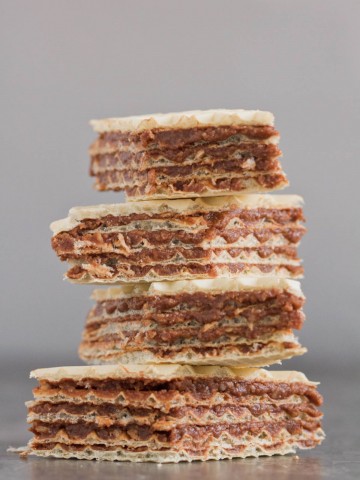

Cooking with Zoki says
I would love to try this juice...You have beautiful blog.
Aida says
Thank you Zoki, and thanks for stopping by. It's very easy to make, and I'm sure you'd like it.
Janine says
Thank you for this recipe. I am impressed with the taste of the juice and will be making it often.
Aida says
Janine,
Glad it turned out well. Thank you for taking the time to let me know.
Emma Cooper says
This looks fab - I've never seen anything about fermenting juniper berries before, so thanks for sharing!
Aida says
Hey Emma, great profile photo! Thanks for stopping by, and I hope you make this juice. It tastes amazing, and it's healthy too.
Doian says
Hi there!
I would like to share with you the way we prepare this drink in Albania. Here we call it Hardiç (pronounced harditch, and don't ask me about the name's etymology cause I don't know).
It is similar to your way but it takes a little more space and time. On the other hand you will have enough for the whole winter or so.
In a 40 liter plastic container (or even metallic but produced for food containing purposes) ad 2kg of fresh juniper berries. Try to not include green ones as they may negatively influence the taste.
Fill the container with potable water and close the lid without force-closing it since the fermentation will increase the volume of the content and may explode the container.
Leave it in a fresh place for 40 days. Afterwards you can try the taste, and if it seems ok start using it. You need to filter the juice with a thin sieve or even with a piece of textile.
If the container comes with a tap be sure to put a filter from the inside already at the beginning.
Every time you take juice from the container you can add the same amount of potable water to it. This should go on for as long as the taste remains the same. When you feel it doesn't taste any more like before it means the juniper berries are ready to be discarded.
Thanks and enjoy.
Aida says
Doian, thank you for leaving such a thoughtful, long comment. I love hearing how similar stuff is prepared across different places. You know I never thought about making a batch that big, but it makes sense. If we ferment vegetables in large buckets, I guess we could do it with juniper berry juice too. We ferment for a much shorter period of time though. Not sure if the size of your bucket has to do with longer fermenting period. Good point about not using the green berries! Cheers!
Doian says
Sorry, in my previous comment there's a mistake in the recipe: not 2kg of juniper but 12kg of juniper berries.
Thanks
Ters says
I have been preparing a modified version of this drink for the last 5 years. As it takes more than a month to complete the fermentation process, I find it impractical to make small quantities such as 1L. I make 10L batches and the only reason why I don't go with larger qty's is price of berries. I live in Canada and usually bring berries from Bosnia, few kg each year, which is insufficient to go with the concept proposed by the poster from Albania - 12kg berries in a large 40L barrel (thank you for posting it). While price of berries in Canada is sort of high, around $30/kg, for rather pretty mediocre quality (and they are actually imported from Balkans). Otherwise, I would love to be able to do it in a 50L barrel and just keep adding water as the good stuff is being consumed rather than keep constantly making 10L jugs for several thirsty mouths :).
From a Bosnian village where I came from, the original recipe included 5L jars with approx 300gr of juniper berries + some rose hip fruit (sipurak) and few slices of some sour apple, properly sealed and to be left in a warm place, such as a sunny window for 3-4 weeks. I modified this process by adding some other dry fruits as well and also having a 2 step fermentation, 3 weeks with berries and fruits at a warmer place (23C) in and 3 weeks without at a bit lower temperature (20C). Due to sugar in small amount of other dry fruits I add, my ready to drink juice has approx 0.5% of alcohol, which only improves quality of the product :).
Aida says
Hi Tersivoje,
Thanks for sharing your fantastic recipe. Smreka - like ajvar and pindjur - is a delicacy everyone adds a personal touch to. I like your idea of adding other fruit - I'll experiment with it.
You're correct, 1l is a small quantity, but perfect as a starting out volume when fermenting the first few times. (The juice is usually diluted a bit, so ultimately this is closer to two liters of juice for consumption.) Most of my readership isn't from the Balkans, and probably wouldn't commit to fermenting 10 or 12 liters of the juice they've never tried. Also, as you mentioned, the berries are rather expensive in North America so it's economical for them to start small. However if/ when they do, now they can.:)
Ters says
Other fruits I use are wild dry cherries (Bosnia), wild dry blueberries (Bosnia), wild dry grape (Canada) all of which add some taste and also a lot of red color, then tamarind (for sour taste), or dates, raisins, dry apricots (Turkey) all of which add mostly sugar. Sometimes lime or lemon. Occasionally wild sour apples when I find some (which I also use to make another specialty from my village - they make apple vinegar only from those small, zero sugar, very sour wild apples - zukve).
And if you want to carbonize the drink, obviously mixing it with sparkling water works, but what also works is to pack the juice in 1L glass or plastic bottles, add a bit of honey (~15gr), use a good cap or plug and leave it for couple weeks. When you open, it will foam like beer :). Obviously, you can use sugar instead, but honey adds a bit of flavor. Fermented honey alone is also one of the old recipes, mead (medovina).
I'm also thinking of getting 1 gallon CO2 pressurized dispenser for tursija. I presently keep it in 1 gallon glass jugs, but a dispenser would be more convenient for "handling".
Aida says
You're really passionate about smreka, I love this! Thank you for taking the time to share it with us. That carbonating idea is great - healthier than your regular soda, and a brand new taste (for most). I think a lot of people will get a lot of good ideas out of your comments!
carla says
I feel so lucky to have access to a LOT of juniper berries locally, that's how I came across the recipe (looking for uses). I have made my own Juniper syrup for pancakes as well as using in my soda machine, as well a Starbucks copycat juniper sage latte. Am eager to try this out, thanks for sharing!
Aida says
Nice! Juniper syrup sounds delicious. Let us know if you make smreka and if you like it.
Julia says
Hi Balkan lunch box!
Wondering if you could help me with the pronunciation of “smreka”, is the S silent?
Very excited to try this recipe, thank you!
Aida says
Hi Julia,
Smreka is pronounced just like it sounds, with a hard "r", so "s-mr-eh-kah". The s isn't silent. Good luck! <3
Ters says
I left couple comments above about 3 years ago. Since then, I improved my process by simply bottling fermented smreka juice to this kind of bottle:
https://www.grolsch.com/sites/default/files/styles/portrait_360x432_/public/2019-01/1200x1200_PilsnerINT_16_Saskia_BLANK.jpg?itok=dSvzX2Qb
To fit 10L, I had to buy 20 of those and "empty" the original content first :). You can buy bottles with similar plug but you might not be able to find as small, those are right size. Most plastic 0.5L water bottles have a good stopped so those will work as well.
Carbonization is easy, just add about 5gr of honey before filling, wait at least 15 days for the honey to ferment, which will create enough CO2 to somewhat pressurize the bottle (assuming that the plug still hold well). If you put a bit too much honey (or sugar) inside, there is risk that a “geyser” will form when you open the bottle. This can be solved by opening bottles which were chilled in the fridge first.
Aida says
Thanks for the comment, it is very thorough and I'm sure a lot of readers will appreciate it.
Ann K says
So much great information! My first batch came out great but rather than lemon I used a bit of 100% maple syrup. That worked. Next time I will try lemon.
Aida says
Ann,
Thanks for letting us know about the maple syrup. It sounds like it would give it such a unique taste!
Rachel says
Is it possible to use pickle pipe fermentation airlock tops? So you don’t have to do the manual burping every couple of days. Will it still be slightly carbonated?
Aida says
Rachel,
thanks for getting in touch.
This is an old school, simple, super easy technique. It only takes a few minutes to stir the berries every few days. (Or once, if you don't feel like it.)
We're not familiar with using pickle pipe fermentation airlock tops. Let us know how it goes if you test them.
If you're asking for our opinion, we always go the most simple route.
Happy fermenting!
Erin says
I made mine and when I bottled it and put it in the fridge, it turned brown. Is that normal? Can I still drink it?
Aida says
Erin,
It never turned brown for us, so we're really not sure. Maybe pour it out just to be on the safe side?
Check these links out, they're in Cro/Bos/Ser, but you'll see the range of color. It's kind of like cloudy white, or yellowish.
https://www.coolinarika.com/recept/sok-od-smreke-5c301ce0-6489-11eb-a896-0242ac1200ac?pretrazivanje=%7B%22pojam%22%3A%22smreka%22%7D
https://www.coolinarika.com/recept/smrekovina-napitak-osvjezenja-i-zdravlja-9db7e502-648a-11eb-8caf-0242ac120093
Amy says
Thank you for this recipe... this is so much fun! I have beautiful Eastern Red Cedar trees near my home and always wondered what to do with the beautiful blue berries. I found your recipe after doing some online research a few years ago. I did not add the lemon juice at first as it seemed to spoil in my very first attempt. However, I added the juice before doing a 2nd ferment (3 days in bottles). Mine turned very fizzy! It was delightful and I just started a new batch yesterday.
Aida says
Amy,
that sounds wonderful! It does have a slight fizziness, which gives it that refreshing kick.
Glad the recipe is working out for you!
Aida